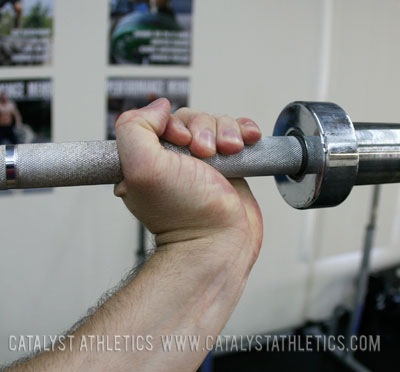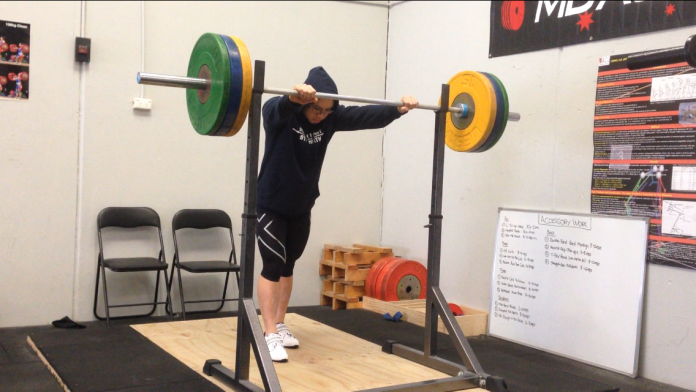Grip is one of the things many fail to pay attention to when lifting. Issues can arise from the grip and go down the chain to the proximal joint of the shoulder.
Here are 5 things to consider regarding your grip which you may not even be thinking about.
1. You are using the hook grip but not really making use of it.
The hook grip is a grip that should allow you to hold onto the bar with too much effort. But despite knowing that, you still grip the bar really tight as though you are at a sale and you are afraid of someone stealing your goods.
 Properly employing the hook grip will allow the weight to sit in the hands instead of having to grab the bar too hard.
Properly employing the hook grip will allow the weight to sit in the hands instead of having to grab the bar too hard.
Learn to let the weight sit in your hook grip. That way, you will be able to take up the slack and have the feeling of the weight of the barbell combined with your centre of mass.
2. Squeezing the bar from the start engages the arms early in the lift.
Related to the first point, by gripping the bar hard, you may fail to take up the slack on the bar and transfer the tension into your trunk. This would then result in the arms being engaged from the start to move the weight or “pull” the weight off the ground.
 Having the arms bend early can result in depending on them to perform the second pull rather than transfer force from the legs to the bar.
Having the arms bend early can result in depending on them to perform the second pull rather than transfer force from the legs to the bar.
One way to establish the awareness to have the weight loaded within your trunk and properly engage the legs to initiate the movement rather than the arms is to gently lift the bar off the ground. As you initiate movement, feel that your shoulders are being pulled down by the weight of the barbell. Once you can establish that, then focus on holding tension in the shoulder blades to get the bar moving off the ground. This will help build the awareness of properly engaging the legs than using the arms early.
3. You are not aware of the angle of your wrists when you set up.
When picking up the lifts, there are already so many key points to keep to that sometimes you feel like it’s impossible to even perform the lift without spending 10 minutes thinking of what you have to do before the lift. How the wrist sits with the bar is something that can determine the proximity of the bar to your body as well as improve the rhythm and tempo of the lifts.
You don’t have to flex your wrists but keeping them flat and maintaining that angle until you have to turn the bar over will definitely help in keeping the bar close and having the bar at the hips when looking to perform the second pull. See this as my explanation for the concept of having the knuckles down from the start.
4. Not releasing the hook grip when receiving the bar COULD (and I repeat COULD) be detrimental to your lockout.
When turning over the bar, there are two approaches to how your grip should be when receiving the bar. One is to release the hook grip and the other is to keep the hook grip. My approach is to release the hook grip as it allows you to have a quicker lockout and it eases off on the wrists when not pulling on the thumbs.
 Releasing the hook grip allows the arms to lock out faster and better after the turnover and when receiving the bar. Image credit to Catalyst Athletics
Releasing the hook grip allows the arms to lock out faster and better after the turnover and when receiving the bar. Image credit to Catalyst Athletics
Most of the time, because there are already so many other points to think about, releasing the hook grip is not one of them. What happens then is active pulling of the bar during the “loop” or turnover. That causes more momentum added to that phase of the movement and increases the requirement for stability in the receiving position. Secondly, it makes the movement of the wrists more of a flick than a rotation around the bar to adopt the receiving position. Of course, if you are mobile enough in your wrists, whether you release the hook grip or not doesn’t really matter if you are not too active in the wrists during that turnover.
5. Trying to pull yourself under the bar doesn’t come from being active in the arms and pulling onto the bar.
Everyone wants to move under the bar fast. And yes, it is important to move under fast. However, transitioning under the bar comes from moving into lower limb joint flexion fast in order to move the body under the bar. Thinking of using the arms to pull under the bar results in unknowingly pulling up continuously on the bar.
Related to the previous point, if you are holding into your hook grip, this will force you to end up using your arms to pull yourself under the bar instead of physically moving your hips down under the bar into the receiving position.
Conclusion
So here are five things regarding your grip which I think could actually hinder movement in your lifting. And most of the time, we seldom focus on the finer points of our grip. I don’t blame you. There are already 99 problems and you think the grip ain’t one.










